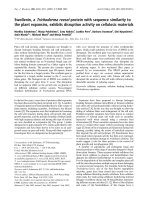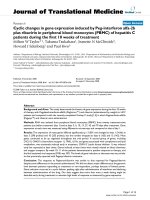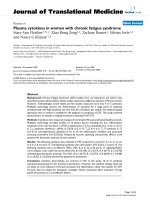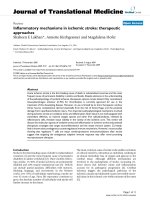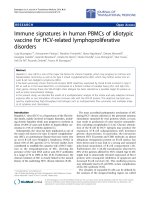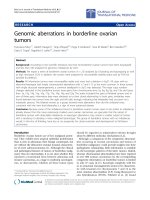Báo cáo hóa học: " Troponin utilization in patients presenting with atrial fibrillation/flutter to the emergency department: retrospective chart review" ppt
Bạn đang xem bản rút gọn của tài liệu. Xem và tải ngay bản đầy đủ của tài liệu tại đây (175.89 KB, 5 trang )
ORIGINAL RESEARCH Open Access
Troponin utilization in patients presenting with
atrial fibrillation/flutter to the emergency
department: retrospective chart review
Nazanin Meshkat
1*
, Emily Austin
2
, Rahim Moineddin
3
, Hamidreza Hatamabadi
4
, Behzad Hassani
5
, Ali Abdalvand
6
and Amanda Marcuzzi
7
Abstract
Background: There are few recommendations about the use of cardiac mar kers in the investigation and
management of atrial fibrillation/flutter. Currently, it is unknown how many patients with atrial fibrillation/flutter
undergo troponin testing, and how positive troponin results are managed in the emergency department. We
sought to look at the emergency department troponin utilization patterns.
Methods: We performed a retrospective chart review of patients with atrial fibrillation/flutter presenting to the
emergency department at three centers. Outcome measures included the rates of troponins ordered by
emergency doctors, number of positive troponins, and those with positive trop onins treated as acute coronary
syndrome (ACS) by consul ting services.
Results: Four hundred fifty-one charts were reviewed. A total of 388 (86%) of the patients had troponins ordered,
13.7% had positive results, and 4.9% were treated for ACS.
Conclusions: Troponin tests are ordered in a high percentage of patients with atrial fibrillation/flutter presenting
to emergency departments. Five percent of our total patient cohort was diagnosed as having acute coronary
syndrome by consulting services.
Introduction
The prevalence of atrial fibrillation is estimated at 0.1%
among adults younger than 55 years, rising with age to 9%
in those older than 80 [1,2], with clear implications in
resource utilization by an aging population. It is estimated
that the number of patients with atrial fibrillation will rise
to about 5.6 million in 2050 from its current number of
2.3 million cases [3]. Atrial fibrillation is a resource-inten-
sive arrhythmia as 70-80% of these patients are admitted
during the course of their illness [4]. More importantly, a
number of studies have shown that the hospitalization
rates for atrial fibrillation have increased, up to 2-3 fold in
the last 2 decades [5,6].
Though there are few recommendations about the use
of cardiac markers in the investigation and management
of atrial fibrillation [7,8], these tests are often ordered to
diagnose myocardial infarction as the cause or conse-
quence of the arrhythmia in patients with atrial fibrilla-
tion or flutter that present to emergency departments.
Unnecessary use of cardiac markers may contribute to
emergency department laboratory costs, delays in
patient discharge if using serial tests, and unnecessary
admission and cardiac investigations for positive tropo-
nins of unknown significance. Currently, it is unknown
how many patients with atrial fibrillation/flutter undergo
troponin testing and how positive troponin results are
managed in the emergency department.
We sought to look at the rates of troponins ordered by
emergency physicians, the rates of positive troponins, and
how many of those with positive troponins were diagnosed
as acute coronary syndrome by admitting services. To our
knowledge, no studies have looked at the use of troponins
in atrial fibrillation/flutter or the impact of positive tropo-
nins on the management of these patients.
* Correspondence:
1
Department of Medicine, Division of Emergency Medicine, University of
Toronto, Toronto, Canada
Full list of author information is available at the end of the article
Meshkat et al. International Journal of Emergency Medicine 2011, 4:25
/>© 2011 Meshkat et al; license e Springer. This is an Open Access article distributed under the terms of the Creativ e Commons
Attribution License ( which permits unrestricted use, distribution, and reproduction in
any medium, provided the original work is prope rly cited.
Methods
Patient population
A retrospective chart review was conducted at three
Canadian centers: two academic emergency departments
(AED 1 and 2) and one community emergency depart-
ment (CED). A list of consecutive patients with new
onset, paroxysmal or permanent atrial fibrillation, or
atrial flutter that pre sented to the emergency depart-
ments during a 12-month period between January and
December 2008 were generated by the health records
departments at each center. All patients with the pri-
mary and secondary diagnosis of atrial fibrillation and
atrial flutter were included. Exclusion criteria were as
follows: patients presenting for INR checks and those
directly admitted to a consulting service.
Research ethics board approval was obtained at all
three sites.
Sample size
To aim for a 95% confidence interval with a width less
than 10% in the estimation of the rates of troponin test-
ing and those treated for acute coronary syndrome, we
reviewed a total of 450 charts (150 charts at each site).
The charts reviewed were selected by systematic sam-
pling from the list generated by the health record
departments (described above). Charts with missing data
were deleted.
Study protocol
Three blinded data abstractors (BH, EA, AM) were trained
by the principal investigator to abstract data using a refer-
ence manual. Data were recorded in a formatted electronic
datab ase. A pilot chart review consisting of 15 ch arts per
center was conducted prior to the study to streamline data
extraction. The principal investigator performed periodic
random checks, and meetings were scheduled to resolve
any disputed data. The intra-rater reliability was deter-
mined using the Cohen’s kappa rating, aiming for a mini-
mum inter-rater reliability of 80%.
All three sites used T roponin I (cTnI) as their cardiac
marker. Two of the sites used the Beckman Coulter TnI
immunoassay, and one site used the Abbott Architect
TnI immunoassay. The cutoff troponin level s used were
the respective coefficient variations of 10% for the speci-
fic immunoassays.
Outcome measures
We looked at the rate of troponin tests ordered by
emergency doctors, those with positive troponins, and
those diagnosed with acute coronary syndrome by the
consulting services (defined as being given the diagnosis
of acute coronary syndrome in the chart by the staff car-
diologist or internist). Patients whose charts indicated
positive troponins were reviewed to determine if alter-
nate reasons for elevated troponin levels other than
acute coronary syndrome had been documented. We
also looked at discharge and referral patterns, emer-
gency department (ED) visit length of stay, and total
emergency de partment (ED) length of sta y. ED visit
length of stay was defined as the time the patient arrived
intheEDuntilthetimetheywereeitherdischargedor
referred by the emergency room physician. Total ED
length of stay was defined as the time the patient arrived
in the ED until the time they left the ED, either after
discharge by the emergency physician or a consulting
service, or after being admitted.
Results
Characteristics of study patients
Between January and December 2008 a total of 1,148
patients with atrial fibrillation/flutter were seen across
the three sites. A total of 451 charts were retrospectively
reviewed. Table 1 summarizes the patient characteristics.
Intra-rater reliability
The kappa statistics for troponin results, presentation of
chest pain, altered mental status, heart rate, hypoten-
sion, and treatment for acute coronary syndrome by
consulting services were 0.9, 1.0, 0.89, 0.89, 0.64 and 1.0,
respectively.
Pattern of troponin testing and results
A total of 388 (86%) of patients had at least one set of
troponin ordered. In those, 13.7% had positive troponin
results, and 4.9% were treated as ACS. Forty percent of
the patients (184/451) were kept for two or more sets of
troponins; of those, 26.6% (49/184) had positive tropo-
nins, and 9.7% (18/184) were treated for ACS by the
consulting service (summarized in Table 2).
The median troponin value was 0.61 ug/L (0.77, 1.19,
0.58 ug/L, resp ectively). Of all patients with positive tro-
ponins, 76.7% had other potential diagnoses for a rise in
troponin other than ACS (demand-related rise in tropo-
nin 35.7%, congestive heart failure 28.5%, renal failure
16.6%, sepsis14.3%, pneumonia 2.3%).
The percentage of patients with positive t roponins
who underwent in-hospital workup for acute coronary
syndrome, such as stress testing and/or angiograms, was
28.3% (15/53), with positive results in 46.7% (7/15).
Referral patterns and ED length of stay
A total of 55% of patients were referred to consulting
services. Those with positive troponins were referred
98% of the time to consulting services. The median ED
visit and ED total length of stay for two sets of tropo-
nins versus patients who were not kept for more than
Meshkat et al. International Journal of Emergency Medicine 2011, 4:25
/>Page 2 of 5
one set of troponins were 374 and 289.5 min, and 808
and 375.5 min, respectively.
Conclusions
Our study iden tified that a high percentage of patients
with atrial fibrillation/flutter is kept in the emergency
department for troponin testing. Eighty-six percent of
patients had at least one set of troponins ordered, and
40% were kept for two or more sets. Our result is simi-
lar to another study, where 42.7% of patients were kept
for a “rule-out myocardial infarction” protocol consisting
of three sets of CK-MB cardiac markers [9].
Table 1 Study and patient population characteristics
AED1 AED2 CED Total
Total ED visits Jan 01 2008 - Dec 31 2008 75,500 57,300 63,000 195,800
Total visits with AF as 1° or 2° Dx 473 271 404 1,148
Patient characteristics (%)
N = 150 N = 151 N = 150 N = 451
Age
< 50 29 (19.3) 22 (14.6) 18 (12.0) 69 (15.3)
51-60 27 (18) 30 (19.9) 16 (10.7) 73 (16.2)
61-74 27 (18.0) 39 (25.8) 45 (30.0) 111 (24.6)
≥ 75 67 (44.7) 60 (39.7) 71 (47.3) 198 (43.9)
Gender
Male 89 (59.3) 98 (64.9) 72 (48.0) 259 (57.4)
Female 61 (40.7) 53 (35.1) 78 (52.0) 192 (42.6)
Type of AF
New onset 51 (34.0) 51 (33.8) 36 (24.2) 138 (30.7)
Paroxysmal 92 (61.3) 93 (61.6) 94 (63.1) 279 (62.0)
Persistent 7 (4.7) 6 (4.0) 9 (6.0) 22 (4.9)
Unknown 0 (0) 1 (0.7) 10 (6.7) 11 (2.4)
Duration of symptoms
< 48 h 91 (60.7) 93 (61.6) 100 (67.1) 284 (63.1)
48 h 56 (37.3) 51 (33.8) 33 (22.2) 140 (31.1)
Unknown 3 (2.0) 7 (4.6) 16 (10.7) 26 (5.8)
Past medical history
History of CHF or EF < 35% 40 (26.7) 30 (19.9) 10 (6.7) 80 (17.9)
HTN 91 (60.7) 80 (53.0) 98 (65.8) 269 (59.8)
CAD 49 (32.7) 31 (20.5) 43 (28.9) 123 (27.3)
DM 20 (13.3) 19 (12.7) 30 (20.1) 69 (15.4)
Previous stroke/TIA 21 (14.0) 23 (15.2) 28 (18.8) 72 (16.0)
Prosthetic heart valve 11 (7.3) 7 (4.6) 5 (3.4) 23 (5.1)
CHADS2 Score*
0 41 (23.7) 45 (29.8) 29 (19.3) 115 (25.5)
1 25 (16.7) 43 (28.5) 40 (26.7) 108 (23.9)
2 34 (22.7) 34 (22.5) 39 (26.0) 107 (23.7)
≥ 3 50 (33.3) 29 (19.2) 42 (28.0) 121 (26.8)
*1 point each for congestive heart failure, hypertension, age > 75 years, diabetes, and 2 po ints for transient ischemic attack or stroke
Table 2 Troponin testing and results
Total
N = 451
At least one troponin ordered 388 (86%)
Positive troponins 53 (13.7%)
Treated as ACS 19 (4.9%)
≥ 2 Troponins ordered 184 (40.8%)
Positive troponin 49 (26.6%)
Treated as ACS 18 (9.7%)
Meshkat et al. International Journal of Emergency Medicine 2011, 4:25
/>Page 3 of 5
In a recent Canadian study, 16.7% (range 10-27%) of
patients with recent onset atrial fibrillation were admitted
from the emergency department [10]. Admission rates
were higher (55%) in our patient population; however, our
study included all patients with atrial fibrillation. In our
study, 14.7% of all those with at least one set of troponins
and 26.6% of those with two or more sets had positive tro-
ponins. Of importance, 98% of patients with positive tro-
ponins were referred on to consulting services; however,
only a third were treated as ACS by c onsulting services
(4.9% of the entire patient cohort). It is possible that
patients with positive troponins who were not treated as
ACS could have required admission for other reasons;
however, our study did not account for that.
The findings of our study have important implications
for clinical practice and resource utilization. Cardiac tro-
ponins, while re latively cardiac-specific, are not disease-
specific and can be positive in the absence of infarction
[11]. For example, in a study of 1,000 consecutive patients
who presented to an urban emergency department with
potential symptoms or signs of coronary ischemia, 45% of
patients with significantly elevated troponin I levels had a
final diagnosis other than ACS [12]. In our study, 79% of
patients with a positive troponin had a potential alterna-
tive diagnosis for a rise in troponin other than ACS, corro-
borating findings from other studies [13]. Demand-related
rise in troponin could account for 35.7% of cases, as has
been seen in numerous other studies [14-17]. In a study of
patients presenting with elevated TnI levels with subse-
quent normal coronary angiogram, tachyarrythmias were
the cause of TnI release in 28% of cases [18]. Failure to
consider these other potential causes of elevated troponin
can lead to unnecessary and invasive cardiac investigations
and resource utilization, which will become of more
importance with the introduction of newer, more sensitive
troponin assays [19]. While it was not within the scope of
this study, our work raises interesting questions about the
possibility of identifying patients with specific symptoms
or characteristics who warrant further diagnostic workup
versus patients who are safe to discharge home. These
types of que stions are best answered in a prospective
study, for which our work sheds light on important char-
acteristic in the study population.
Our study has a few limitations. There was no gold
standard to establish the diagnosis of acute coronary syn-
drome, and since the diagnosis of acute coronary syn-
drome given by cardiologists (and internists) can be open
to interpretation, we cannot say with certainty that those
who were treated for ACS truly required the treatment.
Further, due to the design of our study, we did not look
at adverse events in patients who were and were not trea-
ted for ACS. There are also inherent limitations of a ret-
rospective chart review, such as the lack of clinical
homogeneity among the different sites, missing clinical
data, and variability in data abstraction. Specifically, the
intra-rater reliability was lower for hypotension com-
pared to other variables, as reflected in the lower kappa
statistic. This is likely related to the fact that while even
the data abstraction protocols stated that the ‘presenting’
blood pressure be measured, we did not explicitly define
that this blood pressure should be the triage blood pres-
sure, and not any oth er record. This could have led to
confusion regarding which blood pressure was actually
recorded. Unfortunately, t his was not picked up dur ing
our pilot study and random checks. Despite this, we feel
our results are sufficiently robust given that a kappa of
0.64 still r eflects “substantial agreement,” and all other
kappa values were high.
In summary, a high percentage of patients with atrial
fibrillation/flutter are kept in Canadian emergency depart-
ments for troponin testing, and 4.9% of the total cohort
was treated for acute coronary syndrome. Further prospec-
tive studies are required to study the clinical implications
and prognosis o f patients with positive troponins in
patients with atrial fibrillation/flutter and to identify those
patients who should be tested for troponin and be treated
for acute coronary syndrome.
Acknowledgements
We thank Dr. James Maskalyk for his kind editorial support for the manuscript.
Funding Sources/Grants
2009/2010 Summer Medical Student Scholarships of the Heart and Stroke
Foundation of Ontario (Emily Austin).
Author details
1
Department of Medicine, Division of Emergency Medicine, University of
Toronto, Toronto, Canada
2
Queen’s University, Kingston, Canada
3
Department of Family and Community Medicine, University of Toronto,
Toronto, Canada
4
Division of Emergency Medicine, Shahi d Beheshti
University, Tehran, Iran
5
University of Toronto, Toronto, Canada
6
Shahid
Beheshti University, Tehran, Iran
7
York Central Hospital, Toronto, Canada
Authors’ contributions
NM conceived the study, designed the trial, obtained funding, supervised
the conduct of the trial and data collection, and drafted the manuscript. EA
was a data abstractor, helped with literature review, and edited the first draft
of the manuscript. RM provided statistical advice and analyzed the data. HH
helped with data abstraction. AA helped with data abstraction. BH and AM
were data abstractors.
Competing interests
The authors declare that they have no competing interests.
Received: 19 January 2011 Accepted: 8 June 2011
Published: 8 June 2011
References
1. ATRIA Investigators: Prevalence of diagnosed atrial fibrillation in adults.
National implications for rhythm management and stroke prevention:
the Anticoagulation and Risk Factor in Atrial Fibrillation (ATRIA) Study.
JAMA 2001, 285(18):2370-2375.
2. Kannel WB, Wolf PA, Benjamin EJ, Levy D: Prevalence, incidence,
prognosis, and predisposing conditions for atrial fibrillation: population-
based estimates. Am J Cardiol 1998, 82(8A):2N-9N.
3. Miyasaka Y, Barnes ME, Gersh BJ, Cha SS, Bailey KR, Abhayaratna WP,
Seward JB, Tsang TSM: Secular trends in incidence of atrial fibrillation in
Meshkat et al. International Journal of Emergency Medicine 2011, 4:25
/>Page 4 of 5
Olmsted County, Minnesota, 1980 to 2000, and implications on the
projections for future prevalence. Circulation 2006, 114:119-25.
4. The Atrial Fibrillation Follow-up Investigation of Rhythm Management
(AFFIRM) Investigators: A comparison of rate control and rhythm control
in patients with atrial fibrillation. NEJM 2002, 347:1825-1833.
5. Wattigney WA, Mensah GA, Croft JB: Increasing trends in hospitalization
for atrial fibrillation in the United States, 1985 through 1999. Circulation
2003, 109:711-716.
6. Upshur REG, Moineddin R, Crighton EJ, Mamdani M: Is there a clinically
significant seasonal component to hospital admissions for atrial
fibrillation? BMC Health Serv Res 2004, 4:5.
7. American College of Cardiology/American Health Association Task Force on
practice guideline and the European Society of Cardiology Committee for
Practice Guidelines: ACC/AHA/ESC 2006 Guidelines for the management
of patients with atrial fibrillation – executive summary. Eur Health J
2006, 27:1979-2030.
8. The Task Force for the Management of Atrial Fibrillation of the European
Society of Cardiology: Guidelines for the management of atrial fibrillation:
Eur Heart J 2010, 31:2369-2429.
9. Zimetbaum PJ, Josephson ME, McDonald MJ, McClennen S, Korley V,
Ho KKL, Papageorgiou P, Cohen DJl: Incidence and predictors of
myocardial infarction among patients with atrial fibrillation. J Am Coll
Cardiol 2000, 36:1223-7.
10. Langhan T, Lang ES, Clement CM, Brison RJ, Rowe BH, Borgundvaag B,
Magee K, Stenstrom R, Perry JJ, Birnie D, Wells GA, Xue X, Innes G, Stiell IG:
Predictors of hospitalization in patients presenting to the emergency
department with recent onset atrial fibrillation/flutter [abstract]. CJEM
2010, 12:235.
11. Gupta S, de Lemos JA: Use and misuse of cardiac troponins in clinical
practice. Prog Cardiovasc Dis 2007, 50(2):151-165.
12. Ng SI, Krishnaswamy P, Morrisey R, Clopton P, Fitzgerald R, Maisel AS:
Mitigation of the clinical significance of spurious elevations of cardiac
troponin I in settings of coronary ischemia using serial testing of
multiple cardiac markers. Am J Cardiol 2001, 87:994-9.
13. Gupta S, de Lemos JA: Use and misuse of cardiac troponins in clinical
practice. Prog Cardiovasc Dis 2007, 50(2):151-165.
14. Zellweger MJ, Schaer BA, Cron TA, Pfisterer ME, Osswald S: Elevated
troponin levels in the absence of coronary artery disease after
supraventricular tachycardia. Swiss Medical Weekly 2003, 133:439-41.
15. Kanjwal K, Imran N, Grubb B, Kanjwal Y: Troponin elevation in patients
with various tachycardias and normal epicardial coronaries. Indian Pacing
Electrophysiol J 2008, 8(3):172-4.
16. Nunes JP, Silva JC, Maciel MJ: Troponin I in atrial fibrillation with no
coronary atherosclerosis. Acta Cardiol 2004,
59(3):345-6.
17. Miranda RC, Machado MN, Takakura IT, de Mata PF, da Fonseca CGB,
Mouco OMCC, Hernandes ME, Lemos MABT, Maia LN: Elevated troponin
levels after prolonged supraventricular tachycardia in patient with
normal coronary angiography. Cardiology 2006, 106(1):10-13.
18. Bakshi TK, Choo MKF, Edwards CC, Scott AG, Hart HH, Armstrong GP:
Causes of elevated troponin I with a normal coronary angiogram. Int
Med J 2002, 32:520-5.
19. Keller T, Zeller T, Peetz D, Tzikas S, Roth A, Czyz E, Bickel C, Blds S,
Warnholtz A, Frohlich M, Sinning CR, Eleftheriadis MS, Wild PS, Schnabel RB,
Lubos E, Jahmann N, Genth-Zotz S, Post F, Nicaud V, Tiret L, Lackner KJ,
Munzel TF, Blankenberg S: Sensitive troponin I assay in early diagnosis of
acute myocardial infarction. NEJM 2009, 361(9):868-877.
doi:10.1186/1865-1380-4-25
Cite this article as: Meshkat et al.: Troponin utilization in patients
presenting with atrial fibrillation/flutter to the emergency department:
retrospective chart review. International Journal of Emergency Medicine
2011 4:25.
Submit your manuscript to a
journal and benefi t from:
7 Convenient online submission
7 Rigorous peer review
7 Immediate publication on acceptance
7 Open access: articles freely available online
7 High visibility within the fi eld
7 Retaining the copyright to your article
Submit your next manuscript at 7 springeropen.com
Meshkat et al. International Journal of Emergency Medicine 2011, 4:25
/>Page 5 of 5
